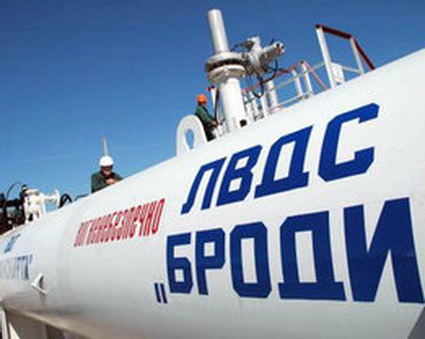
Odessa-Brody Pipeline Operating On Azerbaijani Oil
Publication: Eurasia Daily Monitor Volume: 8 Issue: 59
By:

Oil delivered by Azerbaijan’s State Oil Company (SOCAR) is moving through Ukraine’s Odessa-Brody pipeline at the moment, a portion of it heading for Belarus (BELTA, March 24). SOCAR expects to deliver oil to Poland also through the Odessa-Brody pipeline. The line runs from the Pivdenny terminal on the Black Sea to the Brody junction on the Druzhba pipeline, near the Ukrainian-Polish border. For the first time since its commissioning in 2004, the line is now operating as intended, south-north, for transporting Caspian oil into Central Europe.
The European Union had all along supported this solution from policy considerations –namely, reducing dependence on Russian oil in Ukraine and the neighboring countries. SOCAR, for its part, proceeds from its own business considerations.
Russian companies (primarily TNK-BP) had used the Odessa-Brody pipeline “in reverse,” north-south, for transporting Russian oil to the Black Sea export terminal, from 2004 through 2010. Russia was blocking Caspian oil deliveries via Russian Black Sea ports to Ukrainian ports. This left Ukraine with no choice but to lease the Odessa-Brody pipeline to Russian companies, for reverse-use.
Those companies used the pipeline considerably below its capacity of 10 million tons per year. Under-utilization revealed a deeper motive –namely, booking the pipeline to deny access for non-Russian oil supplies into Ukraine and Central Europe. The Odessa-Brody pipeline became an example of Russian denial-of-access tactics to preserve monopoly positions in Central Europe.
During 2010, however, the Russian government re-directed considerable oil export volumes from the Druzhba and Odessa-Brody pipelines into the recently completed Baltic Pipeline System, with export outlets in Russian Baltic ports. The switch has freed up the entire capacity of the Odessa-Brody pipeline, as well as some capacity in the Druzhba pipeline.
Ukraine, Belarus, and Poland intend to use this opportunity to reduce dependence on Russia by diversifying their oil supplies. Volumes delivered by SOCAR are slated to move in the originally intended direction from Odessa to Brody, then to use a section of the Druzhba pipeline from Brody to the Mozyr refinery in Belarus. The Druzhba pipeline consists of two parallel lines on the Mozyr-Brody section. One line is being prepared for imminent reverse-use, Brody-Mozyr.
SOCAR started oil deliveries by tankers to the Odessa-Pivdenny terminal in January, on a trial-run basis. Onward movement of the high-quality Azeri Light oil had to await the evacuation of residual oil volumes of the lower-quality Russian Urals brand, from both the Odessa-Brody and Brody-Mozyr pipelines. By mid-February, the Azeri oil was moving northward through an Odessa-Brody pipeline operating for the first time in the originally intended direction.
The Belarus Oil Company and SOCAR have contracted for up to 4 million tons of oil to be supplied during 2011 via the Black Sea and Ukraine. Tankers of 80,000 ton capacity are the preferred means of delivery. Apparently, most of those volumes are being carried from Ceyhan (terminal of the Baku-Ceyhan pipeline) via the Mediterranean Sea, the Turkish Straits, and the Black Sea to Ukraine. The Pivdenny port terminal, Odessa-Brody pipeline (both subsidiaries of UkrTransNafta), and Homeltransneft (the Druzhba pipeline company in Belarus) are the transport operators along this route.
Concurrently, SOCAR intends to supply up to 5 million tons of oil for processing by Ukrainian refineries during 2011, up from 1.6 million tons during 2010. The Kremenchug refinery is SOCAR’s leading customer in Ukraine thus far (1News.az, Trend Capital, March 11).
Anticipating the freeing up of the Odessa-Brody pipeline, and concerned about its overdependence on Russian oil, Belarus had negotiated in 2010 for Venezuelan oil deliveries along this route. However, SOCAR initiated a creative arrangement for triangular swaps. Under this arrangement, Venezuela supplies oil volumes of the Santa Barbara brand to SOCAR for marketing in the Western Hemisphere; while Azerbaijan supplies volumes of equivalent value of Azerbaijan’s own oil to Belarus (Trend, March 24).
With the Odessa-Brody pipeline operating northward, a continuation line into Poland becomes realistic. That continuation line had been envisaged at the time when the Ukrainian pipeline was being built. Completed in 2002, however, the Odessa-Brody pipeline was commissioned for Russian reverse-use in 2004. Azerbaijan, Ukraine, Poland, and Lithuania formed the Sarmatia consortium shortly thereafter, to build a continuation line from Brody into Poland. Thwarted during the intervening years, the Sarmatia project now has another chance.
One of SOCAR’s executives, Vitaly Beglyarbekov, has taken over as Sarmatia’s board chairman. The European Commission’s Directorate General for Energy hosted a Sarmatia presentation in Brussels in mid-March. On March 22, the Polish Sejm hosted a hearing with the participation of four cabinet ministers, other state agency chiefs, and the Sarmatia board chairman and CEO. The Polish officials seem set to support a continuation line from Brody to the Plock refinery in Poland. Completion by 2015 is viewed as realistic, contingent however on initial funding from the EU’s infrastructure funds (Trend Capital, March 22).




